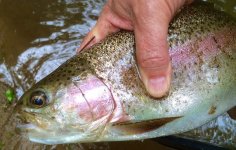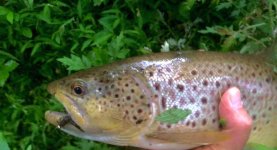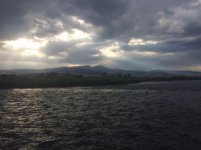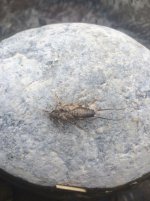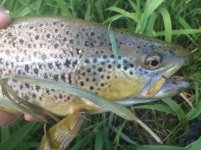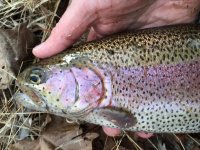Give us a try!
Welcome back to the new NEFF. Take a break from Twitter and Facebook. You don't go to Dicks for your fly fishing gear, you go to your local fly fishing store. Enjoy!
You are using an out of date browser. It may not display this or other websites correctly.
You should upgrade or use an alternative browser.
You should upgrade or use an alternative browser.
Musky today
- Thread starter Lars
- Start date
Lars
I fly fish local NJ streams
Two weeks ago I tried for over an hour for this brown, carefully presenting pretty much every dry fly, nymph, or emerger that I own. No interest. Yesterday I was back at the same spot and she was feeding below surface and took my fly like a torpedo, about a foot from the bank and fifteen feet upstream from where she was last. She is now back in the same spot.
Attachments
Rusty Spinner
Active member
Looks like a WB?
Boy, you are perceptive fluid. It indeed is.
Sssshhhhhhhhhhh, the Musky has no wild browns. We know this because we read it here on NEFF that NJ is only a stocked fishery. :crap:
Lars - check out the newly restored section below Point Mountain. Some nice wild brown water in there now. Brookies too, but lots of brown trout water due to the lower gradient.
Jedi, I was up there last Wed to fish and check out the work. I was very impressed by how natural the renovation appeared. The additional pools and slots should be great holding areas once the micro and macro invertebrates recolonize in a year or so. I was a little puzzled by how much more difficult the wading was at the top of the work area but I assume that will get somewhat better as the newly moved and unsettled rock beds in and steadies. I am a little concerned about flooding moving and/or destroying the new banks and bars. How do you guys work this into your planning?
Steve
Steve
Rusty Spinner
Active member
Jedi, I was up there last Wed to fish and check out the work. I was very impressed by how natural the renovation appeared. The additional pools and slots should be great holding areas once the micro and macro invertebrates recolonize in a year or so. I was a little puzzled by how much more difficult the wading was at the top of the work area but I assume that will get somewhat better as the newly moved and unsettled rock beds in and steadies. I am a little concerned about flooding moving and/or destroying the new banks and bars. How do you guys work this into your planning?
Steve
Great questions, Steve. We make our structures more or less bullet proof. As far as restored point/gravel bars, by their very nature, they are supposed to move and change every high water event. That is why they exist, to move smaller material downstream. We build those in natural deposition zones so that they grow in some events, shrink in others, and change shapes in still other events. But due to how we build them, they won't totally blow out ever if we do our jobs correctly. Thanks for taking a look at the work.
In short time, with rains and flows over them, all of our pools and point bars will harden up. I'll be out there tomorrow to see how the approx. 340 cfs flows affected the pools, our track machine marks, and our point bars along with my native seed mixes. We don't see much changes in a river like the Musky even in the flood of record which was Hurricane Irene that gave us over 9,000 cfs and didn't move our major structures on the Warren Rod & Gun Club's waters we restored a year or two before that event.
Rusty Spinner
Active member
I was very impressed by how natural the renovation appeared.
For the record, statements like this make me happier than you would know. We strive very hard to make any restoration project look as natural for that particular watershed as we can and our work does not look the same in every river system. Instead, we spend lots of time looking at good stretches of the streams and rivers we are restoring so that we can best mimic those features in our restorations. For this part of the Musky, two things jumped out that I insisted we mimic and that is large boulders sticking above the water's surface in base flows and in the lower gradient sections (especially in the Wattles section), long, slow pools. We did not make what I have been accused of by some that have no clue what we do as a "western trout river". Instead, each river/stream is treated as an individual as it should be so that we carry those critical characteristics that make that water unique.
Rusty Spinner
Active member
Ah yes, when the application of science verges on art.
Steve
That science is brought to you by yours truly, Lance my senior project manager, Eric our brilliant designer, and Joe (fisheries biologist and current owner) who taught us what we know today. The art is brought to you by "cowboy" Ron, our operator for the last 30+ years. The CAT bucket is his paintbrush and the river his palette. He has an amazing ability to bring our designs and concepts to reality and make it look like it was always there.
flymantis73
I am haunted by waters
It's looking good up there Rusty!
Lars
I fly fish local NJ streams
... we spend lots of time looking at good stretches of the streams and rivers we are restoring so that we can best mimic those features in our restorations. For this part of the Musky, two things jumped out that I insisted we mimic and that is large boulders sticking above the water's surface in base flows and in the lower gradient sections (especially in the Wattles section), long, slow pools. We did not make what I have been accused of by some that have no clue what we do as a "western trout river". Instead, each river/stream is treated as an individual as it should be so that we carry those critical characteristics that make that water unique.
Brian, I'm glad that this time you restored a low gradient site and I am eager to go up there to see the work. Can you comment on the following: From poking around our larger rivers my sense is that it is the low gradient habitats that historically have been most affected by human activities. The channels often appear to, over time, have been substantially widened producing very shallow water and low water velocities. As a result, there are substantial distances of both the Musky and SB that are low-gradient but today consist mainly of low-stability sand, silt, and small pebbles that I imagine are not the greatest insect or trout habitast, and that heat the water and suck up oxygen when flows are low on warm summer days. It probably is not a coincidence that many of the best fishing areas are in high gradient location, such as KLG or Point Mountain. And, so, are there any plans to target additional low-gradient locations for future rehabilitation, or is that a difficult proposition?
Rusty Spinner
Active member
Brian, I'm glad that this time you restored a low gradient site and I am eager to go up there to see the work. Can you comment on the following: From poking around our larger rivers my sense is that it is the low gradient habitats that historically have been most affected by human activities. The channels often appear to, over time, have been substantially widened producing very shallow water and low water velocities. As a result, there are substantial distances of both the Musky and SB that are low-gradient but today consist mainly of low-stability sand, silt, and small pebbles that I imagine are not the greatest insect or trout habitast, and that heat the water and suck up oxygen when flows are low on warm summer days. It probably is not a coincidence that many of the best fishing areas are in high gradient location, such as KLG or Point Mountain. And, so, are there any plans to target additional low-gradient locations for future rehabilitation, or is that a difficult proposition?
You hit the nail on the head with gradient and NJ's stream condition issues. Far too many - including watershed groups - have little clue what our rivers and streams looked like prior to the mid to later 1800s when all our trees were cut 100% and farmers farmed right to the edges of our stream banks which began the widening we see today. Then add in the ever-growing numbers of roads, homes and businesses built that don't allow rains to regenerate our groundwater as they should given all the impervious surfaces, and our rivers have widened even more over the last hundred or so years.
As for targeting just lower gradient areas, that's not how stream restoration works on the levels we're seeing here in this state. Instead, restorations are done when a willing landowner agrees and when funding is found in spite of how one might want to prioritize certain areas. Perhaps one day we will be enlightened enough to target large sections of rivers and streams for restoration if for no other reason than to improve our drinking water supplies. Trout and drinking water go hand in hand!
Rusty Spinner
Active member
Three nice days on the Madison River.View attachment 11909View attachment 11910View attachment 11908
Nice! A little bit cooler than the Musky is today.....

